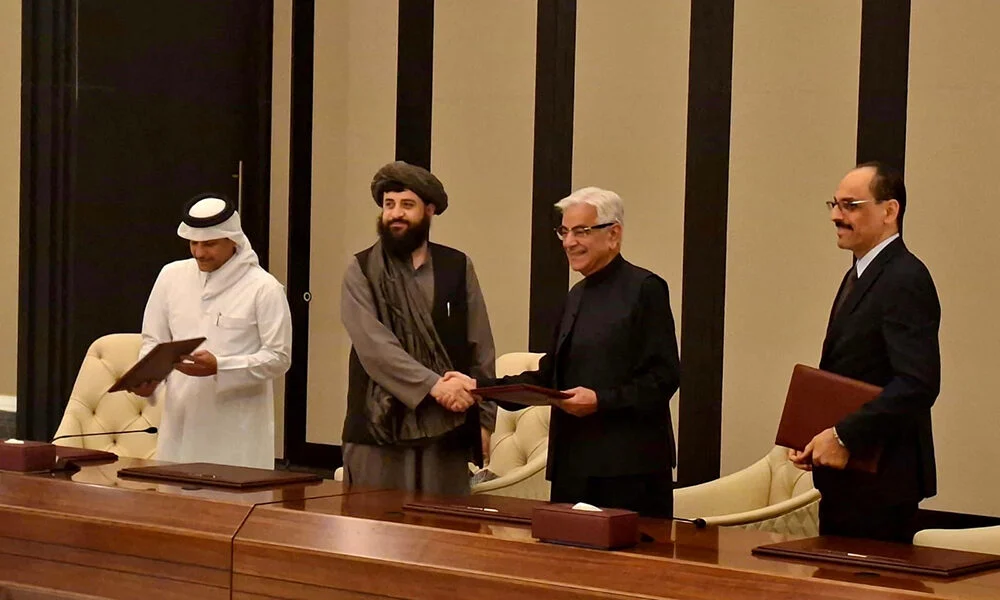The long-standing tension between Afghanistan and Pakistan has its roots in colonial borders, shifting alliances and enduring grievances. The 2,600-kilometre frontier, known as the Durand Line, was drawn in 1893 by the British Empire to demarcate spheres of influence between British India (now India and Pakistan) and Afghanistan, splitting the Pashtun and Baloch communities across the new boundary. Afghanistan has never formally recognised it as an international border. At the same time, Pakistan insists on its legitimacy and has, in recent decades, built fencing along its stretches to curb smuggling and militant crossings.
With the 1947 partition of British India, the rivalry deepened: Afghanistan voted against Pakistan’s admission to the United Nations and backed Pashtun nationalist claims in Pakistan’s border regions. Meanwhile, Pakistan aligned with the United States during the Soviet occupation of Afghanistan (1979–89), while Afghanistan leaned on Soviet (and later Indian) support. In the 1990s, Pakistan backed the rise of the Taliban as a friendly regime in Kabul to secure its western flank and gain ‘strategic depth’ against India. The post 9/11 2001 US-led invasion uprooted that arrangement and created a new phase of proxy tensions.
Key drivers of the conflict include:
- Irredentism (one state’s desire to annex the territory of another state): The cross-border ties of the Pashtun population, fostering competing nationalist and irredentist claims.
- Security and terrorism issues: Pakistan accuses Afghanistan of harbouring the Tehreek e Taliban Pakistan (TTP), responsible for attacks in Pakistan, including the Peshawar school massacre of 2014; Afghanistan accuses Pakistan of supporting insurgents (including the Afghan Taliban) during the US presence.
- Economic and refugee stresses: trade routes, water disputes (such as over the Kabul River), and flows of millions of Afghan refugees into Pakistan have added friction. Pakistan’s deportation of more than one million undocumented Afghans since 2023 has further worsened relations.
- Influence of regional powers: India has invested heavily in Afghan infrastructure (over US $3 billion) to limit Pakistan’s influence; Pakistan accuses India of using Afghanistan to support militants such as the Baloch Liberation Army.
- Tensions have escalated repeatedly. Before 2021, border skirmishes and Pakistani airstrikes hit Afghanistan. After the Taliban’s 2021 return, cross-border artillery and airstrikes resumed (2022–24). In early October 2025, Pakistan targeted TTP leader Noor WaliMehsud in Kabul, sparking Afghan retaliation on border posts, killing dozens, including civilians.
Effects on the Region – Including India
The conflict destabilises South and Central Asia, halting progress. Trade routes like the China–Pakistan Economic Corridor (CPEC) and Afghanistan’s Chabahar Port, backed by India, face disruptions. Millions of refugees burden Pakistan’s economy and unsettle Iran and Central Asia.
For India:
- Security: Pakistan’s focus on its western border diverts resources from the eastern front (including Kashmir), yet the turmoil increases risks of militant spill-over via Afghanistan.
- Economic and diplomatic: India stands to gain from a stable Afghanistan for trade access to Central Asia, bypassing Pakistan; conversely, instability impedes projects like the Turkmenistan–Afghanistan–Pakistan–India Pipeline (TAPI). Historically, India engaged the Taliban cautiously while supporting anti-Taliban groups — anticipating Afghanistan as a proxy battleground linking Pakistan.
- Broader: The conflict raises nuclear and conventional escalation risks in South Asia, while China, reliant on stability for CPEC, and Russia/Iran, seeking to limit US influence, all have stakes.
The Temporary Ceasefire: Details and Effects
On 19 October 2025, Afghanistan and Pakistan agreed to an immediate ceasefire during talks in Doha mediated by Qatar and Türkiye. The truce was preceded by intense cross-border clashes – air-strikes, artillery fire and dozens of deaths – the worst since the Taliban’s return in 2021.
Key terms and follow-up:
- Both sides agreed that “neither country will undertake any hostile actions against the other, nor will they support groups carrying out attacks against the Government of Pakistan”.
- Pakistan’s Defence Minister Khawaja Muhammad Asif emphasised the ceasefire will only hold if Afghanistan curbs militant incursions from its territory. “Everything hinges on this one clause.”
- Follow-up talks were scheduled in Istanbul on 25 October to flesh out verification and monitoring mechanisms.
Effects:
- For the conflicting nations: The pause gives Islamabad breathing room to verify Taliban control over the TTP; Kabul avoids further attrition and faces a chance to demonstrate sovereignty.
- For the region: The immediate risk of spill-over is reduced; trade (which had dropped from around US$1.5 billion pre-escalation) could resume; India may regain access to Afghan markets and resources; refugee pressures could ease and connectivity projects resume.
- But: The ceasefire remains fragile. Analysts warn that the agreement excludes non-state actors and militants not party to the talks.
Political, Diplomatic, Economic Factors
Under conflict: Politically, both governments face internal pressure – Pakistan’s government is criticised for soft approaches to TTP; the Taliban regime uses anti-Pakistan rhetoric to consolidate its power. Diplomatically, both sit in isolation: Pakistan’s relations with the US strain over Taliban-Pakistan ties, Afghanistan remains largely unrecognised. Economically, the war disrupts trade, forces increased military spending and hampers growth; refugee costs burden Pakistan, sanctions strain Afghanistan.
Under peace: Politically, the ceasefire builds trust and creates space for governance and domestic reform (for example, Taliban legitimacy via diplomacy). Diplomatically, doors open for recognition, NATO-style multilateral dialogue (via Qatar, Türkiye). Economically, trade and energy/infrastructure projects (like TAPI) become viable; peace could add billions to GDPs through connectivity.
Why no war is better: War means human suffering, economic drain and risk of escalation (including nuclear). Peace enables focus on poverty (Afghanistan’s GDP per capita ~US$500) and undermines extremism by bolstering livelihoods. Region-wide, peace prevents refugee crises, curtails terrorism spill-over and supports integration, which reduces poverty and radicalisation.
Spoilers: Who May Not Want Peace?
Several actors stand to benefit from continued instability:
- Terror groups like TTP and Islamic State Khorasan Province (ISIS-K) thrive in chaos, using porous borders and failed states as bases.
- Some analysts argue that India benefits indirectly from Pakistan’s western distraction, allowing eastern pressures and denial of CPEC progress, which India disproves by officially supporting Afghan stability.
- Within the US, some hawkish factions and defence-industrial interests prefer low-level instability to justify the ‘global war on terror’ framework.
- Arms suppliers and private dealers profit from war; their revenues shrink under sustained peacetime.
Despite the rhetoric of revenge or destruction, current policies (Russia’s delisting of the Taliban from the terrorist list in July 2024, the US’s continued emphasis on counter-terrorism rather than ground war) suggest that major powers now lean towards stability rather than perpetual confrontation. Nonetheless, the path is complex.
A Balanced Assessment and Humanitarian Perspective
The ceasefire of 19 October 2025 stands as a cautious but significant step. Given the long-standing grievances, shared frontier, and complex regional entanglements, the agreement is noteworthy – yet its durability is far from assured. The challenge lies in enforcement: Will Kabul truly rein in non-state actors such as TTP? Will Islamabad respect Afghan sovereignty and cease strikes? Will monitoring and verification mechanisms be credible?
From a humanitarian standpoint, this moment offers relief. Border communities, previously living under the threat of air strikes, shelling and displacement, now have a tentative respite. Refugees may find a route home; trade may restart; education, health and livelihoods in the border belt may recover. In India, hosting 14,000 Afghan refugees, the ceasefire offers hope for families dreaming of returning home safely.
For the public, the tale is also one of hope: history need not be destiny. The colonial drawing of the Durand Line divided peoples; the post-1947 rivalry escalated that division. Yet here we see neighbours choosing to halt guns before words.
Why This Ceasefire Matters – And Why We Should Care
Put simply – because thousands have died; millions have been displaced; trade and development have suffered; and the region of South and Central Asia has fed up of instability, with repercussions far beyond the two states.
- The densely populated borderlands have for decades borne the brunt of conflict.
- Economically, a stable Pakistan-Afghanistan axis opens pathways to Central Asia, benefiting not only local communities but also India and global connectivity.
- Diplomatically, the ceasefire signals that even the most entrenched rivalries can pause guns and pick up dialogue.
- From a humanitarian perspective, the ceasefire reduces civilian deaths, protects children from becoming refugees, and preserves livelihoods.
Outlook and Possibilities
The immediate outlook remains cautious optimism. If both parties commit in earnest, the ceasefire could evolve into a longer-term dialogue, enable border trade resumption, refugee returns and regional development. But risks remain: stalemate, unmet commitments, or renewed violence could undo progress quickly. Key to watch: monitoring mechanisms, how militants and non-state actors are handled, whether economic incentives tilt towards cooperation rather than competition.
A Beginning, Not an End
The temporary ceasefire between Pakistan and Afghanistan is not a guarantee of peacebut it is a critical opening. For the people who live along the fractured frontier, for refugees hoping to return, for trade corridors waiting to move again, and for regional actors seeking stability, it offers a fragile yet genuine hope. If nurtured, this moment could mark a pivot from perpetual conflict to cautious cooperation. And in that possibility lies the hope that people, not borders, come first.


